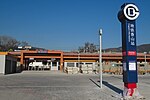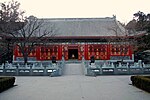Tuancheng Fortress

The Tuancheng Fortress or Tuan Cheng Fortress (Chinese: t 團城演武廳, s 团城演武厅, p Tuánchéng Yǎnwǔtīng, lit. "Round Wall Fortress") is a historic 18th-century fortress located near the Fragrant Hills in the Haidian District of Beijing, China. Today, the fortress is a national museum and is also known as the Tuancheng Exhibition Hall. The fortress was built in the 14th year of the Qianlong Emperor's reign (1749 CE). Tuancheng was a castellated military training compound used by the Qing to train, inspect, and honor their troops.The site is especially well preserved. Today, the fortress frequently holds large-scale martial arts events and attracts fans from all around China.
Excerpt from the Wikipedia article Tuancheng Fortress (License: CC BY-SA 3.0, Authors, Images).Tuancheng Fortress
Xiang Shan South Road, Haidian District
Geographical coordinates (GPS) Address Nearby Places Show on map
Geographical coordinates (GPS)
| Latitude | Longitude |
|---|---|
| N 39.9852 ° | E 116.204 ° |
Address
中国科学院植物研究所香山分子育种基地
Xiang Shan South Road
100094 Haidian District
Beijing, China
Open on Google Maps










